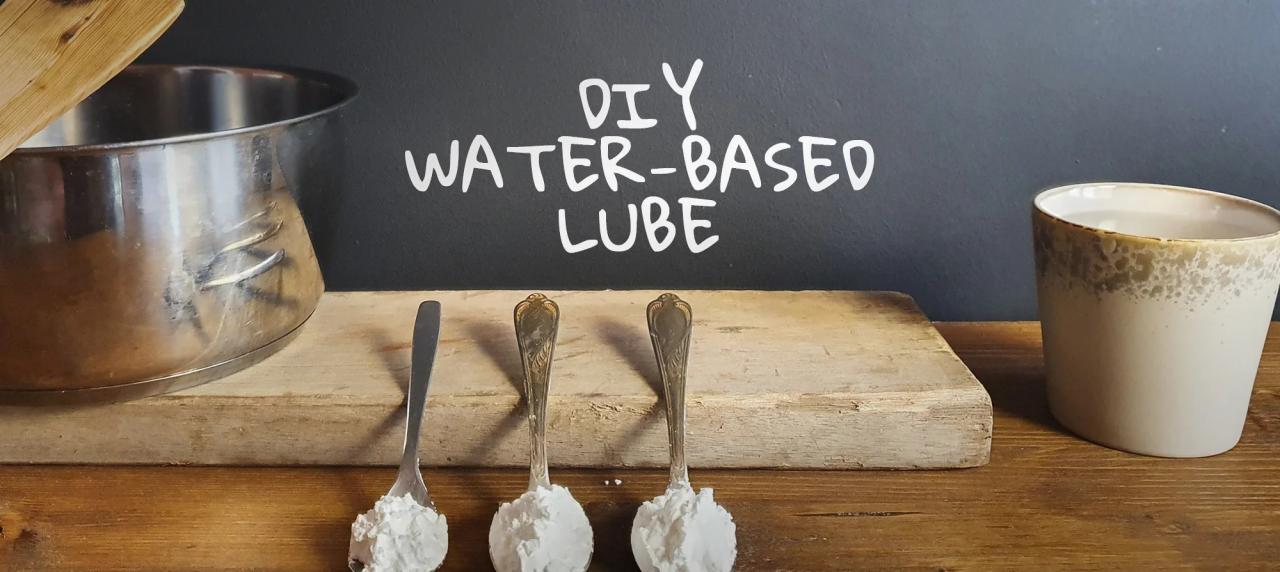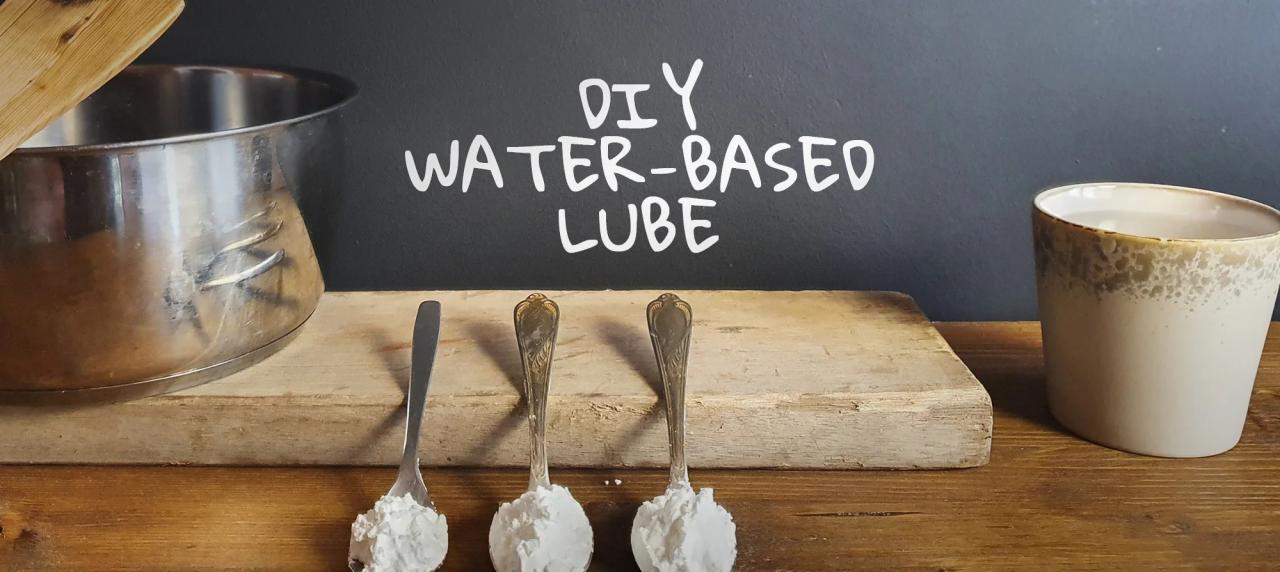Diy water based lube – DIY water-based lube offers a unique and potentially cost-effective way to enjoy the benefits of personal lubrication. This guide explores the ins and outs of creating your own water-based lube, from simple recipes to safety considerations.
Water-based lubes have become increasingly popular due to their compatibility with various materials, including latex condoms, and their generally gentle nature on the skin. However, creating your own lube comes with its own set of considerations, including ingredient selection, safety protocols, and proper storage.
DIY Water-Based Lube Recipes: Diy Water Based Lube
Making your own water-based lube is a fun and cost-effective way to have more control over the ingredients and avoid potentially irritating chemicals. Here are a few simple recipes using readily available ingredients.
Water-Based Lube Recipes
Here are three recipes for water-based lubes:
Simple Recipe 1: Aloe Vera and Water
- Ingredients: 1/4 cup aloe vera gel, 1/4 cup distilled water
- Instructions:
- Combine aloe vera gel and distilled water in a clean bowl.
- Mix well until the ingredients are thoroughly combined.
- Store in an airtight container in the refrigerator for up to 2 weeks.
This recipe is simple and gentle, suitable for sensitive skin. Aloe vera is known for its soothing properties and can help to moisturize the skin.
Simple Recipe 2: Glycerin and Water
- Ingredients: 1/4 cup vegetable glycerin, 1/4 cup distilled water
- Instructions:
- Combine vegetable glycerin and distilled water in a clean bowl.
- Mix well until the ingredients are thoroughly combined.
- Store in an airtight container in the refrigerator for up to 2 weeks.
Glycerin is a humectant, meaning it attracts and retains moisture, making it a great ingredient for lubrication. This recipe is simple and effective.
Simple Recipe 3: Cornstarch and Water
- Ingredients: 1 tablespoon cornstarch, 1/2 cup distilled water
- Instructions:
- Combine cornstarch and distilled water in a saucepan.
- Heat over medium heat, stirring constantly, until the mixture thickens.
- Remove from heat and allow to cool completely.
- Store in an airtight container in the refrigerator for up to 2 weeks.
This recipe uses cornstarch to create a thicker, more slippery lube. It is important to cook the mixture properly to ensure that the cornstarch is fully dissolved and the lube is safe to use.
Safety Precautions
It is essential to use clean ingredients and equipment when making DIY lube. Always wash your hands thoroughly before handling ingredients and ensure all containers and tools are clean. Always test a small amount of lube on a small area of skin before applying it to a larger area to check for any allergic reactions.
Comparison of DIY Water-Based Lube Recipes
| Recipe | Ingredients | Consistency | Benefits |
|---|---|---|---|
| Aloe Vera and Water | Aloe vera gel, distilled water | Thin | Soothing, moisturizing |
| Glycerin and Water | Vegetable glycerin, distilled water | Medium | Humectant, slippery |
| Cornstarch and Water | Cornstarch, distilled water | Thick | Slippery, long-lasting |
Safety Considerations for DIY Lube

Creating your own lube can be a fun and empowering experience, but it’s crucial to prioritize safety. While DIY lubes can be a great alternative to store-bought options, there are potential risks involved that you need to be aware of. Understanding these risks and taking the necessary precautions can ensure a safe and enjoyable experience.
Potential Risks Associated with DIY Lube
It’s important to understand the potential risks associated with using DIY lube. While many DIY lube recipes are safe and effective, there are certain things to be aware of.
- Allergic Reactions: Ingredients like essential oils, fragrances, or even some natural ingredients can cause allergic reactions in some people. It’s essential to patch test any new ingredients on a small area of skin before using them in a DIY lube.
- Irritation and Sensitivity: Certain ingredients can cause irritation or sensitivity, especially if you have sensitive skin. It’s best to use gentle, hypoallergenic ingredients and avoid ingredients that are known to be irritating, such as alcohol or harsh chemicals.
- Contamination: If not made and stored properly, DIY lube can become contaminated with bacteria or fungi. This can lead to infections or other health problems.
- Incorrect Formulation: Using the wrong ingredients or proportions can result in a lube that is too thick, too thin, or even unsafe to use. It’s essential to follow trusted recipes and to understand the properties of each ingredient.
Avoiding Contamination During the Making Process
Contamination is a serious concern when making DIY lube. Here’s how to minimize the risk:
- Cleanliness is Key: Wash your hands thoroughly with soap and water before starting. Sterilize all equipment, including containers, measuring tools, and utensils, using boiling water or a bleach solution (1 part bleach to 10 parts water).
- Use Fresh Ingredients: Use only fresh, high-quality ingredients. Avoid using ingredients that have expired or are past their prime.
- Store Properly: Store your DIY lube in a clean, airtight container in a cool, dry place. Avoid storing it in direct sunlight or heat.
- Label Clearly: Label your DIY lube with the date it was made and the ingredients used. This will help you track its shelf life and ensure you’re using it safely.
Storing DIY Lube for Optimal Shelf Life, Diy water based lube
Proper storage is essential for maximizing the shelf life of your DIY lube and preventing contamination.
- Airtight Containers: Store your lube in clean, airtight containers to prevent air and moisture from entering, which can lead to bacterial growth and spoilage.
- Cool, Dry Place: Store your DIY lube in a cool, dry place, away from direct sunlight and heat. These conditions can degrade the ingredients and shorten the shelf life.
- Limited Shelf Life: Even with proper storage, DIY lube has a limited shelf life. Most DIY lubes are best used within 1-2 months, depending on the ingredients used.
Ethical Considerations of DIY Lube

Creating and using DIY lube raises ethical considerations, especially regarding safety, accessibility, and responsible practices. It’s crucial to understand the potential implications and make informed decisions.
Safety Concerns and Responsibility
The safety of DIY lube is paramount. Using improper ingredients or failing to follow safety protocols can lead to irritation, allergic reactions, or even infections.
“It’s essential to prioritize safety when making DIY lube. Using only high-quality, safe ingredients and following proper sanitation practices is crucial.”
- Ingredient Selection: Carefully choose ingredients known to be safe for intimate use. Avoid substances that can irritate or cause allergic reactions.
- Sanitation: Maintain a clean and hygienic environment during the preparation process. Thoroughly wash all tools and containers used.
- Testing: Always test the lube on a small area of skin before full use. This helps identify potential sensitivities or reactions.
Future Trends in Water-Based Lube
The world of water-based lube is constantly evolving, driven by advancements in technology and consumer demand for safer, more effective, and sustainable options. This dynamic landscape presents exciting opportunities for innovation, with new ingredients, formulations, and delivery methods emerging on the horizon.
Advancements in Water-Based Lube Technology
The future of water-based lube is likely to be shaped by technological advancements that enhance performance, comfort, and user experience.
- Biodegradable and Eco-Friendly Lube: As environmental concerns grow, the demand for eco-friendly and biodegradable lube is increasing. Researchers are exploring sustainable ingredients derived from renewable sources, such as plant-based polymers and natural oils, to create lube that breaks down easily and minimizes environmental impact.
- Personalized Lube: The future may see the rise of personalized lube formulations tailored to individual needs and preferences. This could involve customizing the viscosity, pH, or scent of the lube based on factors like skin sensitivity, sexual activity, or personal taste.
- Smart Lube: Imagine lube that can monitor and adjust its properties based on real-time feedback. This could involve incorporating sensors to detect temperature, pH, or moisture levels, allowing the lube to adapt its viscosity or lubrication properties accordingly.
- Lube with Enhanced Sensory Experiences: Some manufacturers are exploring the use of ingredients that enhance sensory experiences, such as cooling agents, warming agents, or even aromatherapeutic oils. These innovations aim to create a more pleasurable and engaging experience for users.
Emerging Trends in Ingredients and Formulations
The search for safer, more effective, and sustainable ingredients is driving innovation in water-based lube formulations.
- Plant-Based Polymers: These polymers, derived from natural sources like corn starch or seaweed, offer a biodegradable and eco-friendly alternative to traditional synthetic polymers. They provide excellent lubrication and are less likely to irritate sensitive skin.
- Natural Oils: Some manufacturers are incorporating natural oils like jojoba oil or coconut oil into their formulations. These oils offer natural lubrication, emollience, and potential antibacterial properties.
- Hyaluronic Acid: This naturally occurring substance is known for its ability to attract and retain moisture. When added to lube, it can enhance hydration and lubrication, providing a silky smooth feel.
- Probiotics: Some researchers are exploring the potential benefits of incorporating probiotics into lube formulations. Probiotics can help maintain a healthy vaginal microbiome, which may contribute to overall vaginal health.
The Future of DIY Water-Based Lube
DIY water-based lube has gained popularity, driven by a desire for greater control over ingredients and a sense of personal empowerment.
- Simplified DIY Kits: We may see the emergence of pre-packaged DIY kits that provide all the necessary ingredients and instructions for making custom lube at home. This would make the process more accessible and convenient.
- Online Resources and Communities: Online platforms and communities dedicated to DIY lube are likely to grow, providing a space for sharing recipes, tips, and best practices. This can foster a sense of community and encourage experimentation.
- Increased Transparency and Sustainability: As DIY lube gains traction, there will be a growing emphasis on transparency and sustainability. Consumers will be looking for recipes that use safe, ethically sourced, and eco-friendly ingredients.
Conclusion: The Power of Water-Based Lube
Water-based lubes offer a safe, effective, and versatile solution for enhancing intimacy and personal well-being. This exploration has shed light on the diverse world of water-based lubes, from DIY recipes to ethical considerations. It’s crucial to remember that informed use is key to maximizing benefits and minimizing risks.
The Importance of Safe and Informed Use
Safe and informed use of water-based lubes is paramount. Always choose high-quality ingredients, prioritize safety measures, and consider potential sensitivities or allergies. Understanding the nuances of water-based lubes empowers you to make informed choices that align with your individual needs and preferences.
“Always prioritize safety and consult with a healthcare professional if you have any concerns or questions about using water-based lubes.”
Whether you’re seeking a natural alternative, a more budget-friendly option, or simply enjoy the DIY process, crafting your own water-based lube can be a rewarding experience. Remember to prioritize safety, conduct thorough research, and consult with a healthcare professional if you have any concerns. Ultimately, the journey to a comfortable and enjoyable experience is paved with knowledge and informed choices.
Making your own water-based lube can be a fun and cost-effective project, and it’s surprisingly easy to customize to your preferences. If you’re feeling crafty, you might also enjoy building a DIY wooden dog bed for your furry friend. While the two projects seem unrelated, they both involve a bit of creativity and the satisfaction of making something yourself.
And just like your DIY lube, a well-crafted dog bed can bring a lot of comfort and joy to your pet’s life.

